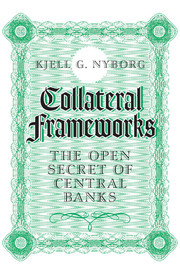Book contents
- Frontmatter
- Contents
- List of Figures
- List of Tables
- List of Exhibits
- List of Examples
- Preface
- Acknowledgments
- 1 Background and Motivation
- 2 Collateral Frameworks: Overview
- 3 Monetary Policy Implementation in the Euro Area over Time
- 4 Evidence on the Production and Usage of Collateral
- 5 Haircuts
- 6 Ratings and Guarantees
- 7 Market and Theoretical Prices
- 8 Collateral “Own Use”
- 9 Non-regulated Markets, Unsecured Bank Debt, and LTRO Uptake
- 10 Market Discipline
- 11 Bailing Out the Euro
- 12 The Endgame of the Euro Crisis
- 13 Restoring Credibility
- 14 The Problem with Collateral
- 15 Concluding Remarks
- Appendix: Haircut and Rating Rules Updates
- References
- Index
4 - Evidence on the Production and Usage of Collateral
Published online by Cambridge University Press: 06 January 2017
- Frontmatter
- Contents
- List of Figures
- List of Tables
- List of Exhibits
- List of Examples
- Preface
- Acknowledgments
- 1 Background and Motivation
- 2 Collateral Frameworks: Overview
- 3 Monetary Policy Implementation in the Euro Area over Time
- 4 Evidence on the Production and Usage of Collateral
- 5 Haircuts
- 6 Ratings and Guarantees
- 7 Market and Theoretical Prices
- 8 Collateral “Own Use”
- 9 Non-regulated Markets, Unsecured Bank Debt, and LTRO Uptake
- 10 Market Discipline
- 11 Bailing Out the Euro
- 12 The Endgame of the Euro Crisis
- 13 Restoring Credibility
- 14 The Problem with Collateral
- 15 Concluding Remarks
- Appendix: Haircut and Rating Rules Updates
- References
- Index
Summary
Eligible collateral comes from many different asset classes, ranging from government bonds to asset-backed securities. Non-marketable assets can also be eligible. This chapter reports on the nominal amounts of eligible collateral across different marketable asset classes from 2004 to 2013. It also reports on banks’ actual usage of collateral across these asset classes and non-marketable assets. By comparing the usage data with the eligible collateral value data, it is possible to get a sense of the extent to which there are biases in the collateral framework. If all eligible collateral have the same opportunity costs, we would expect to see no distinct preference for using collateral from particular asset classes. Thus, in this chapter, I compare the fraction of eligible collateral that is used across asset classes.
Table 4.1 provides the nominal value of eligible marketable collateral from 2004 to 2013. The data are compiled by the ECB and available on its webpage (see the caption of Table 4.1). The ECB provides the data broken down into seven asset classes. These are, from top to bottom in the table, central government securities, regional government securities, supranational and agency securities (“other marketable assets”), covered bank bonds, corporate bonds, uncovered bank bonds, and asset-backed securities. As will be shown in Chapter 5, collateral haircuts in the Eurosystem are increasing in these asset classes in the order just cited. Thus, we can think of these asset classes as having decreasing “quality” in terms of risk and liquidity, as reflected by haircuts.
Table 4.1 shows that, in aggregate, the nominal value of eligible marketable collateral has nearly doubled from 2004 to 2013, going from EUR 7,646 to 14,183 billion. These are relatively large numbers in comparison with the size of the ECB's operations and balance sheet as well as the monetary base, as discussed above. For example, the nominal value of eligible marketable collateral in 2013 is approximately 19.8 times the amount lent through the ECB's operations (item 5 on the balance sheet) and 10.9 times the combined size of item 5 and item 7 (outright collateral holdings).
- Type
- Chapter
- Information
- Collateral FrameworksThe Open Secret of Central Banks, pp. 52 - 58Publisher: Cambridge University PressPrint publication year: 2016



